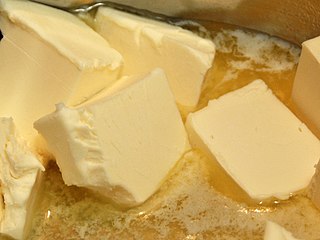
Butter is a dairy product made from the fat and protein components of churned cream. It is a semi-solid emulsion at room temperature, consisting of approximately 80% butterfat. It is used at room temperature as a spread, melted as a condiment, and used as a fat in baking, sauce-making, pan frying, and other cooking procedures.
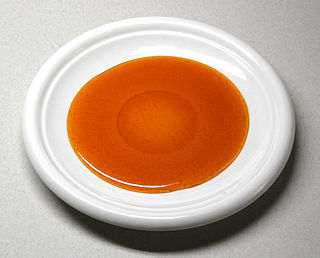
Caramel is an orange-brown confectionery product made by heating a range of sugars. It can be used as a flavoring in puddings and desserts, as a filling in bonbons or candy bars, or as a topping for ice cream and custard.
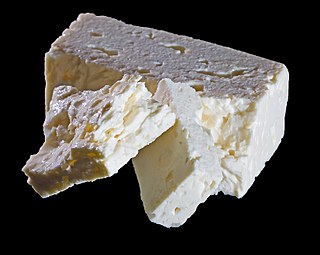
Feta is a Greek brined white cheese made from sheep's milk or from a mixture of sheep and goat's milk. It is soft, with small or no holes, a compact touch, few cuts, and no skin. Crumbly with a slightly grainy texture, it is formed into large blocks and aged in brine. Its flavor is tangy and salty, ranging from mild to sharp. Feta is used as a table cheese, in salads such as Greek salad, and in pastries, notably the phyllo-based Greek dishes spanakopita "spinach pie" and tyropita "cheese pie". It is often served with olive oil or olives, and sprinkled with aromatic herbs such as oregano. It can also be served cooked, as part of a sandwich, in omelettes, and many other dishes.

Beurre blanc is a warm emulsified butter sauce made with a reduction of vinegar and/or white wine and shallots into which softened whole butter is whisked in off the heat to prevent separation. The small amount of emulsifiers naturally found in butter, including a trace of lecithin, is used to form an oil-in-water emulsion. Although similar to hollandaise in concept, it is considered neither a classic leading nor compound sauce. This sauce originates in Loire Valley cuisine.
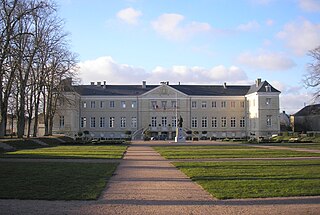
Isigny-sur-Mer is a commune in the Calvados department and Normandy region of north-western France.

Beurre noisette is a type of warm sauce used in French cuisine. It can accompany savoury foods, such as winter vegetables, pasta, fish, omelettes, and chicken. It has become a popular ingredient in other cultures as well, such as in contemporary American Italian cuisine or the traditional American chocolate chip cookie. It is widely used in making French pastry. It has a deep yellow, almost brown, colour and a nutty scent and flavour from the heating process.
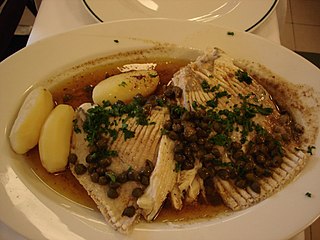
Beurre noir is melted butter that is cooked over low heat until the milk solids turn a very dark brown. As soon as this happens, acid is carefully added to the hot butter, usually lemon juice or a type of vinegar. Some recipes also add a sprig of parsley, which is removed from the hot butter before the acid is added. It is typically served with eggs, fish, or certain types of vegetables.
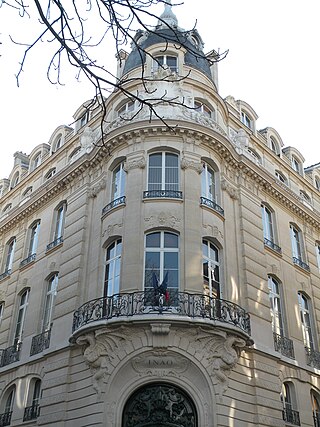
In France, the appellation d'origine contrôlée(AOC) is a label that identifies an agricultural product whose stages of production and processing are carried out in a defined geographical area – the terroir – and using recognized and traditional know-how. The specificity of an AOC product is determined by the combination of a physical and biological environment with established production techniques transmitted within a human community that, together, give the product its distinctive qualities. These crucial technical and geographic factors are set forth in standards for each product, including wines, cheeses and meats. Other countries and the European Union have similar labeling systems. The European Union's protected designation of origin (PDO and PGI) system has harmonized the protection of all geographical indications and their registration. When labelling wine however, producers may still use recognized traditional terms like AOC, and are not required to display the PDO and PGI logos or terms, mostly for aesthetic purposes.
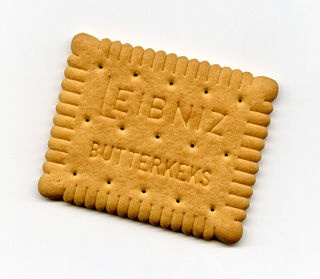
The Leibniz-Keks or Choco Leibniz is a German brand of biscuit or cookie produced by the Bahlsen food company since 1891. It was created by the firm as a rival to a similar French biscuit, the Petit-Beurre.
D'Isigny is a soft, creamy American cheese, bearing a close resemblance to imported Brie, but made by a process similar to that for Camembert and put up in Camembert shape, though a little larger – about 1+1⁄2 inches (38 mm) thick and 6 inches (150 mm) across, wrapped in paper and weighing about a pound. It takes its name from Isigny-sur-Mer, in Calvados, Normandy, France, a center of dairy products such as beurre d'Isigny and crème d'Isigny, and the namesake of Walt Disney, the founder of The Walt Disney Company.
Beurre monté refers to melted butter that remains emulsified, even at temperatures higher than that at which butter usually breaks down. Beurre monté may refer either to the melted butter sauce itself, or to the method of making it.

Compound butters are mixtures of butter and other ingredients used as a flavoring, in a fashion similar to a sauce.
Beurre Rose is a cultured milk butter produced in Luxembourg under the Marque Nationale of the Grand Duchy of Luxembourg. It is sometimes consumed as a spread, but most commonly used as an ingredient in a variety of sweet and savory dishes.
Beurre d’Ardenne is a type of butter made in the Ardenne of Belgium from cow's milk.

The Petit Beurre, or Véritable Petit Beurre, also known under the initials VPB, is a type of shortbread from Nantes, that is best known in France in general and especially in Pays de la Loire. The Petit Beurre of the LU company, which has become a success worldwide, is one example in particular. The dry biscuit was invented in 1886 by Louis Lefèvre-Utile in the city of Nantes and was inspired by some English products of the time. The LU Petit Beurre was not the first to appear, and the name is not exclusive to LU.

Beurre maître d'hôtel, also referred to as maître d'hôtel butter, is a type of compound butter of French origin, prepared with butter, parsley, lemon juice, salt and pepper. It is a savory butter that is used on meats such as steak, fish, vegetables and other foods. It may be used in place of a sauce, and can significantly enhance a dish's flavor. Some variations with a sweet flavor exist. It is usually served cold as sliced disks on foods, and is sometimes served as a side condiment.

A jambon-beurre, also known as a parisien, is a French ham sandwich made of a fresh baguette sliced open, spread with butter and filled with slices of ham.
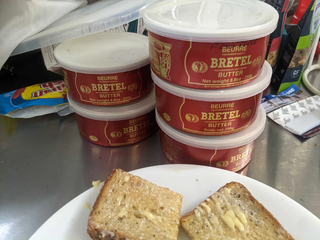
Bretel butter is a brand of canned butter popular among Vietnamese people. It is exported from France.













